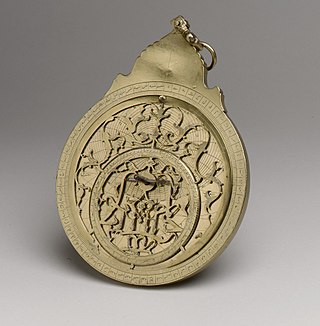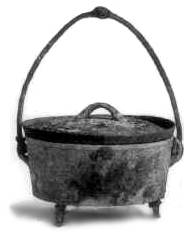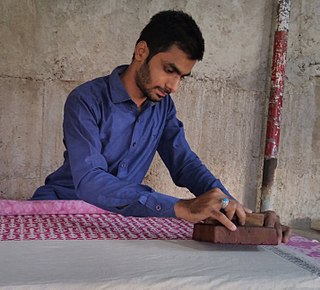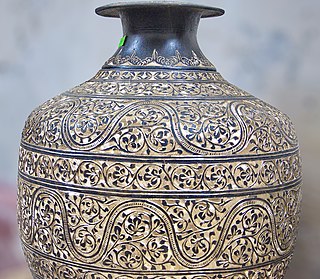
An alloy is a mixture of chemical elements of which at least one is a metal. Unlike chemical compounds with metallic bases, an alloy will retain all the properties of a metal in the resulting material, such as electrical conductivity, ductility, opacity, and luster, but may have properties that differ from those of the pure metals, such as increased strength or hardness. In some cases, an alloy may reduce the overall cost of the material while preserving important properties. In other cases, the mixture imparts synergistic properties to the constituent metal elements such as corrosion resistance or mechanical strength.

Brass is an alloy of copper (Cu) and zinc (Zn), in proportions which can be varied to achieve different colours and mechanical, electrical, acoustic, and chemical properties, but copper typically has the larger proportion. In use since prehistoric times, it is a substitutional alloy: atoms of the two constituents may replace each other within the same crystal structure.

Bronze is an alloy consisting primarily of copper, commonly with about 12–12.5% tin and often with the addition of other metals and sometimes non-metals, such as phosphorus, or metalloids such as arsenic or silicon. These additions produce a range of alloys that may be harder than copper alone, or have other useful properties, such as strength, ductility, or machinability.

Electroplating, also known as electrochemical deposition or electrodeposition, is a process for producing a metal coating on a solid substrate through the reduction of cations of that metal by means of a direct electric current. The part to be coated acts as the cathode of an electrolytic cell; the electrolyte is a solution of a salt of the metal to be coated; and the anode is usually either a block of that metal, or of some inert conductive material. The current is provided by an external power supply.

An alum is a type of chemical compound, usually a hydrated double sulfate salt of aluminium with the general formula XAl(SO
4)
2·12 H
2O, such that X is a monovalent cation such as potassium or ammonium. By itself, "alum" often refers to potassium alum, with the formula KAl(SO
4)
2·12 H
2O. Other alums are named after the monovalent ion, such as sodium alum and ammonium alum.

An ingot is a piece of relatively pure material, usually metal, that is cast into a shape suitable for further processing. In steelmaking, it is the first step among semi-finished casting products. Ingots usually require a second procedure of shaping, such as cold/hot working, cutting, or milling to produce a useful final product. Non-metallic and semiconductor materials prepared in bulk form may also be referred to as ingots, particularly when cast by mold based methods. Precious metal ingots can be used as currency, or as a currency reserve, as with gold bars.

A Dutch oven or casserole dish (international) is a thick-walled cooking pot with a tight-fitting lid. Dutch ovens are usually made of seasoned cast iron; however, some Dutch ovens are instead made of cast aluminum, or ceramic. Some metal varieties are enameled rather than being seasoned, and these are sometimes called French ovens. The international name casserole dish is from the French casserole which means "cooking pot". They are similar to both the Japanese tetsunabe and the sač, a traditional Balkan cast-iron oven, and are related to the South African potjie, the Australian Bedourie oven and Spanish cazuela.

The ghaṭam is a percussion instrument used in various repertoires across the Indian subcontinent, especially in Southern India. Its variant is played in Punjab and known as gharha as it is a part of Punjabi folk traditions. Its analogue in Rajasthan is known as the madga and pani mataqa.

A coppersmith, also known as a brazier, is a person who makes artifacts from copper and brass. Brass is an alloy of copper and zinc. The term "redsmith" is used for a tinsmith that uses tinsmithing tools and techniques to make copper items.

Scrap consists of recyclable materials, usually metals, left over from product manufacturing and consumption, such as parts of vehicles, building supplies, and surplus materials. Unlike waste, scrap has monetary value, especially recovered metals, and non-metallic materials are also recovered for recycling. Once collected, the materials are sorted into types — typically metal scrap will be crushed, shredded, and sorted using mechanical processes.

A tinsmith is a person who makes and repairs things made of tin or other light metals. The profession may sometimes also be known as a tinner, tinker, tinman, or tinplate worker; whitesmith may also refer to this profession, though the same word may also refer to an unrelated specialty of iron-smithing. By extension it can also refer to the person who deals in tinware, or tin plate. Tinsmith was a common occupation in pre-industrial times.
In metallurgy, non-ferrous metals are metals or alloys that do not contain iron in appreciable amounts.

The Hoxne Hoard is the largest hoard of late Roman silver and gold discovered in Britain, and the largest collection of gold and silver coins of the fourth and fifth centuries found anywhere within the former Roman Empire. It was found by Eric Lawes, a metal detectorist in the village of Hoxne in Suffolk, England in 1992. The hoard consists of 14,865 Roman gold, silver, and bronze coins and approximately 200 items of silver tableware and gold jewellery. The objects are now in the British Museum in London, where the most important pieces and a selection of the rest are on permanent display. In 1993, the Treasure Valuation Committee valued the hoard at £1.75 million.

Corinthian bronze, also named Corinthian brass or aes Corinthiacum, was a highly valuable metal alloy in classical antiquity. It is thought to be an alloy of copper with gold or silver, although it has also been contended that it was simply a very high grade of bronze, or a kind of bronze that was manufactured in Corinth. It is referred to in various ancient texts, but no certain examples of Corinthian bronze exist today. However, it has been increasingly suggested that a number of artefacts previously described as niello in fact use a technique of patinated metal that may be the same as Corinthian bronze and is similar to the Japanese Shakudō.

The crafts of India are diverse, rich in history, culture and religion. The craft of each state in India reflect the influence of different empires. Throughout centuries, crafts have been embedded as a culture and tradition within rural communities.

Traditional metal working in Mexico dates from the Mesoamerican period with metals such as gold, silver and copper. Other metals were mined and worked starting in the colonial period. The working of gold and silver, especially for jewelry, initially declined after the Spanish conquest of the Aztec Empire. However, during the colonial period, the working of metals rose again and took on much of the character traditional goods still have. Today, important metal products include those from silver, gold, copper, iron, tin and more made into jewelry, household objects, furniture, pots, decorative objects, toys and more. Important metal working centers include Taxco for silver, Santa Clara del Cobre for copper, Celaya for tin and Zacatecas for wrought iron.

A kalasha, also called Pūrṇa-Kalaśa, Pūrṇa-Kumbha, Pūrṇa-Ghaṭa, also called ghat or ghot or kumbh, is a metal pot with a large base and small mouth. It is employed in the rituals in Hindu, Jain, and Buddhist traditions as a ceremonial offering to the deity or to an honoured guest and as an auspicious symbol used to decorate shrines and buildings.

Hidalgo (state) handcrafts and folk art are mostly made for local consumption rather than for collectors, although there have been efforts to promote this work to a wider market. Most are utilitarian and generally simply decorated, if decorated at all. The most important handcraft traditions are pottery, especially in the municipality of Huejutla and textiles, which can be found in diverse parts of the state. Most artisans are indigenous, with the Otomi populations of the Mezquital Valley being the most dominant. Other important handcrafts include basketry, metal and wood working.

The brassware industry in Bangladesh is considered as a cottage industry and artisans with high workmanship make brass crafts by hand. The brassware of Bangladesh has good reputation in international market for uniqueness.


















